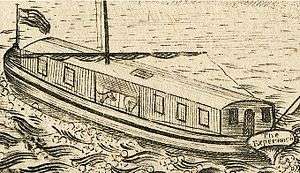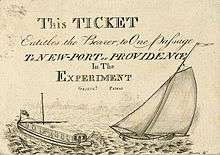Experiment (horse-powered boat)
 The Experiment | |
| History | |
|---|---|
| Name: | Experiment |
| Builder: | David Wilkinson |
| General characteristics | |
| Tonnage: | 12 |
| Length: | 100 feet (30 m) |
| Beam: | 20 feet (6.1 m) |
| Installed power: | eight horses on a treadmill contraption |
| Propulsion: | "goose-foot paddle" large mechanical screw propeller |
| Speed: | 4 knots (7.4 km/h; 4.6 mph) |


The Experiment was an early nineteenth-century boat powered by horses and incorporating the then novel idea of a screw propeller.[1][2]
History
The Experiment was a horse-powered ferry boat. It was a twelve-ton three-mast boat drawing a few feet of water, about 100 feet long by 20 feet beam.[3] Its driving mechanism, an in-water screw, was invented by David Grieve in 1801. The boat was constructed by David Wilkinson (some sources give his name as Varnum[4]) in 1807 to 1810, depending on the source.[5][6][7] It was propelled by a "goose-foot paddle" large mechanical screw propeller in the water (instead of a paddle wheel at water surface).[6] The new technology devised by Grieve and Wilkinson was powered by eight horses on a treadmill. The horse boat technology to propel the boat upstream was originally invented by David Grieve and granted a patent February 24, 1801, in the patent category of "Boats to ascend rivers". The complete recorded patent was lost in the 1836 U.S. Patent Office fire.[1] The novel idea of propelling vessels upstream by the use of a large mechanical screw in the water is now referred to as Ericsson’s propeller.[3]
It is reported that the Experiment made one unsuccessful voyage, as it ran aground on the return trip. The mechanism and associated parts were put together by Ephraim Southworth. Little thought was put into planning the construction, and it was poorly built.[8] The maiden test voyage was in June 1809 of a group of gentlemen from the Grand Lodge of the State.[9] The first attempt of the "Screw Boat" began at Jackson's Wharf on Eddy's Point near Providence, Rhode Island, with a destination of Pawtuxet Village.[10] The eight horses for the "horse power", owned by Marvin Morris, were connected mechanically to a poorly designed contraption to make the boat move. It obtained a top speed of four knots with the help of a tide going in her direction and the wind on her back. It managed to get to Pawtuxet Village, where there was much celebration over its success. The return trip, however, resulted in humiliation when a gust of wind drove the Experiment onto mud flats, causing its demise.[10][11]
The Experiment venture had sold shares of stock from a prospectus to raise money to build it.[9] There was so much confidence in the venture that tickets were engraved by William Hamlin for its anticipated voyages to New-Port and Providence.[2][12] Ultimately, the horse boat and all the associated items were seized by the Sheriff at the behest of Grieve's creditors (or investors) and sold for lack of payments on the loans, since it was not a successful venture.[10] Alternatively, Wilkinson later said that "after the frolic" it was "hauled up" and allowed to go to waste and ruin.[6]
Nevertheless, the ship was carefully studied by Daniel French, who did the drawings for Robert Fulton's North River Steamboat (known as Clermont), and may have benefited that enterprise.[6]
The Experiment is important as a precursor of public transport on rivers, and it was the forerunner of a number of horse powered boats, chiefly ferries, used for more than a half century along the eastern seaboard of the United States. Most commonly, those were paddle wheel boats, not screw type propellers.[13][14][15] Inclined treadmills were often used.[13]
See also
- Animal-powered transport
- Horse-drawn boat
- Team boat
- Horse mill
- Horse engine
- Marine propulsion
- Paddle steamer includes comment regarding animal drive ships
- Roller ship (a failed experiment) ship design of the late nineteenth century, which attempted to propel itself by means of large wheels.
- Treadwheel
- Working animal
References
Notes
- 1 2 Sheaff, Dick. "Powered Boats". Ephemera. Retrieved 12 December 2011.
- 1 2 Lane, Gladys R. (Librarian of the Shepley Library, Providence, Rhode Island) (19 March 1925). Rhode Island's Earliest Engraver. VII. Antiques Magazine. p. 133.
- 1 2 Bishop, James Leander; Freedley, Edwin Troxell; Young, Edward (1864). A history of American manufactures from 1608 to 1860: exhibiting the origin and growth of the principal mechanic arts and manufactures, from the earliest colonial period to the adoption of the constitution and comprising annals of the industry of the United States in machinery. 2. E. Young & Co. p. 12. Retrieved 12 December 2011.
- ↑ VanWyk, Eugene (April 1961). "William Hamlin: Providence Engraver" (PDF). Rhode Island History. 20 (2): 36. Retrieved 12 December 2011.
- ↑ Rhode Island Society for the Encouragement of Domestic Industry (1859). Transactions of the Rhode Island Society for the Encouragement of Domestic Industry. Rhode Island Society for the Encouragement of Domestic Industry. Retrieved 13 December 2011. p. 31 Mr. Varnum Wilkinson, now living (1859), built " The Experiment," he thinks in 1809 or 1810.
- 1 2 3 4 Field, Edward (1902). State of Rhode Island and Providence Plantations at the end of the century: a history. 2. Mason Pub. Co. p. 510. Retrieved 12 December 2011.
- ↑ "Early Experiments in Steam Power". Scientific American Supplement. 23 (593): 9464. 14 May 1887. Retrieved 12 December 2011.
- ↑ Field, p. 511–512
- 1 2 Rhode Island Society, p. 30
- 1 2 3 Hazard, p. 294
- ↑ Grieve, Robert (1920). The Sea Trade in Rhode Island an Providence Plantations. New York: American Historical Society, Inc. pp. 511–512. Retrieved 14 December 2011.
- ↑ Rhode Island Historical Society collections,. 15–18. Rhode Island Historical Society. 1922. p. 96. Retrieved 14 December 2011.
- 1 2 Perkins, Sid (21 May 1999). "When Horses Really Walked On Water: Before the steam engine was invented, there were three sources of usable power: wind, water, and animals. The first of these to be harnessed — literally — was animal.". The Chronicle of the Horse. pp. 90–92. Retrieved 12 December 2011.
- ↑ Crisman, Kevin J.; Cohn, Arthur B. (1998). When Horses Walked On Water: Horse-Powered Ferries in Nineteenth-Century America. Smithsonian Institution Press. p. 292.
- ↑ Kennard, Jim (2 July 2005). "Lake Champlain: Horse Powered Ferry Boat discovered in Lake Champlain". Shipwreck World. Retrieved 12 December 2011.
Sources
- Bishop, James Leander; Freedley, Edwin Troxell; Young, Edward (1864). A history of American manufactures from 1608 to 1860: exhibiting the origin and growth of the principal mechanic arts and manufactures, from the earliest colonial period to the adoption of the constitution and comprising annals of the industry of the United States in machinery. 2. E. Young & Co. p. 12. Retrieved 12 December 2011.
- Crisman, Kevin J.; Cohn, Arthur B. (1998). When Horses Walked On Water: Horse-Powered Ferries in Nineteenth-Century America. Smithsonian Institution Press. p. 292. Retrieved 13 December 2011.
- "Early Experiments in Steam Power". Scientific American Supplement. 23 (593): 9464. 14 May 1887. Retrieved 12 December 2011.
- Field, Edward (1902). State of Rhode Island and Providence Plantations at the end of the century: a history. 2. Mason Pub. Co. p. 510. Retrieved 12 December 2011.
- Grieve, Robert (1920). The Sea Trade in Rhode Island an Providence Plantations. New York: American Historical Society, Inc. pp. 511–512. Retrieved 14 December 2011.
- Hazard, Samuel (1841). Hazard's United States commercial and statistical register. 4. W. F. Geddes. p. 294. Retrieved 13 December 2011.
- Kennard, Jim (2 July 2005). "Lake Champlain: Horse Powered Ferry Boat discovered in Lake Champlain". Shipwreck World. Retrieved 12 December 2011.
- Lane, Gladys R. (Librarian of the Shepley Library, Providence, Rhode Island) (19 March 1925). Rhode Island's Earliest Engraver. VII. Antiques Magazine. p. 133.
- Perkins, Sid (21 May 1999). "When Horses Really Walked On Water: Before the steam engine was invented, there were three sources of usable power: wind, water, and animals. The first of these to be harnessed — literally — was animal.". The Chronicle of the Horse. pp. 90–92. Retrieved 12 December 2011.
- Sheaff, Dick. "Powered Boats". Ephemera. Retrieved 12 December 2011.
- VanWyk, Eugene (April 1961). "William Hamlin: Providence Engraver" (PDF). Rhode Island History. 20 (2): 36. Retrieved 12 December 2011.